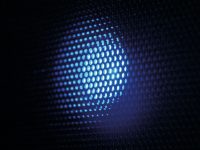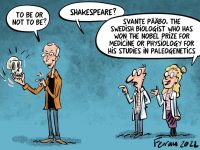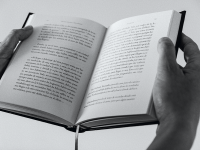Vacation stories
Santiago Ramón y Cajal’s fiction

Santiago Ramón y Cajal, father of neuroscience, won the Nobel Prize in Medicine in 1906 for his neuron theory. But besides being a great histologist, researcher, and teacher, he showed interest in photography, philosophy, astronomy, chess, and hypnosis. He was the author of some very important scientific and biographical work as well as his Vacation stories. Five science fiction tales, is a collection of five short stories with an educational purpose that mix scientific concepts, fiction, and some irony, and where microscopy and microbiology are always present. These stories raise difficult social or moral dilemmas that were often motivated by advances in science or the inadequate scientific education of the general population. Cajal sought to improve that education and banish false beliefs and superstitions.
Keywords: neuroscience, Santiago Ramón y Cajal, literature, science fiction, popularisation.
The origin of science fiction
Some authors argue that the term science fiction was coined in 1929 by Hugo Gernsback (1884–1967), editor of one of the first genre magazines, and popularised by John W. Campbell’s Astounding Science Fiction magazine in 1938. However, it was William Wilson who used the term for the first time in 1851, in A little earnest book upon a great old subject (Novell Monroy, 2008; Oliveros-Aya, 2015; Pérez-Rodríguez, 2007).
Gernsback defined science fiction as fantasy narratives that combine fiction, scientific fact, and prophetic vision. Other terms such as futuristic literature, scientific novel, or scientific fiction were also used (Pérez-Rodríguez, 2007).
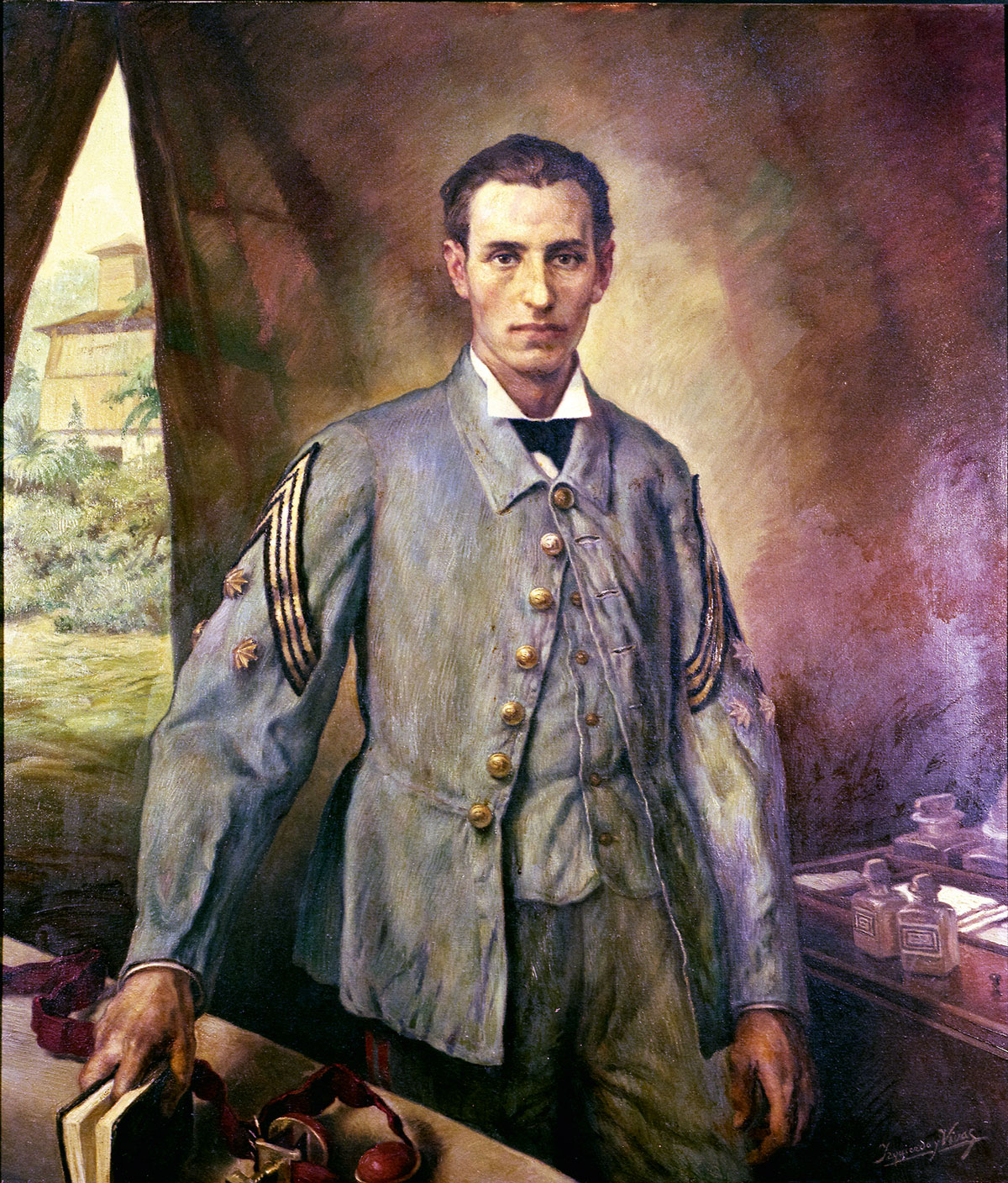
Science fiction receives numerous influences, for example, from extraordinary journeys or utopias, which appear in works such as Homer’s Odyssey (eighth century BC) which narrates the return of Ulysses to Ithaca. It also incorporates many fantastic elements, such as those found in Lucian of Samosata’s A true story (125–192), a parody of travel stories, which even includes an interstellar battle and a trip to the Moon, long before Jules Verne (1828–1905) wrote From the Earth to the Moon (1865), or George Méliès (1861–1938) immortalised it in his famous film A trip to the Moon (1902). Antiphanes of Athens (408–334 BC) and Herodotus (484–426 BC) also wrote about fantastic journeys as if they were true stories. The first to confess that they were pure fiction was Lucius Apuleius (125–180), author of The golden ass and a passionate traveller (Novell Monroy, 2008; Pérez-Rodríguez, 2007).
Some authors believe that science fiction began with these fantastic travel works. Others, that it was born with Frankenstein; or, the modern Prometheus by Mary Shelley (1797–1851), published in 1818. In the book, which has been adapted to cinema many times, Dr. Victor Frankenstein manages to create life from body fragments, using electricity generated by a storm (Novell Monroy, 2008). The author had probably read or heard a lecture on Luigi Galvani’s (1737–1798) experiments with frogs and electricity, and that gave her the idea for her novel (Miscione, 2015). It was not only about the creation of life from corpses, but also about the debate about supporting or rejecting scientific and technological advances because of their harmful effects or ethical implications (Novell Monroy, 2008). Finally, the birth of this genre is also sometimes related to Le dernier homme (“The last man”, 1805) by Jean Baptiste Cousin de Grainville (1746–1805), the first modern novel to reference the end of the world.
These precedents notwithstanding, Jules Verne, the author of Around the world in eighty days (1873), Journey to the centre of the Earth (1864), Michael Strogoff (1876), and Twenty thousand leagues under the sea (1870), is often considered the father of the genre. The French writer used the latest scientific discoveries, such as submarine science, and integrated them into a fantasy world, but he also invented and anticipated new ideas. For example, Verne placed the shuttle of his trip From the Earth to the Moon in Florida, in Cape Canaveral, NASA’s current rocket launch site; and in Propeller island (1895) he mentioned a global telephoto information network that transmitted image and sound (Otis, 2001).
«Cajal’s father considered reading novels to be harmful to his health, as well as a waste of time»
Other important genre authors in the late nineteenth and early twentieth century include: Robert Louis Stevenson (1850–1894), author of Strange Case of Dr. Jekyll and Mr. Hyde (1886); Herbert G. Wells (1866–1946), with his novels The time machine (1895), The invisible man (1897), The island of Doctor Moreau (1896), The war of the worlds (1898), and The first men in the Moon (1901); Jack London (1876–1916), with A thousand deaths (1899), The rejuvenation of Major Rathbone (1899), The shadow and the flash (1903), and The unparalleled invasion (1910); and Arthur Conan Doyle (1859–1930), creator of the most famous detective in literature, Sherlock Holmes, who applied observation and deduction to solve his cases and was inspired by Doctor Joseph Bell (1837–1911), the writer’s professor. In addition, Conan Doyle wrote numerous science fiction works, such as The lost world (1912), The poison belt (1913), When the world screamed (1928), The disintegration machine (1929), and The land of mist (1926).
All these authors used scientific jargon and substituted the supernatural with science or with an idea that could plausibly be explained scientifically, using a tone between fantasy, wonderment, and realism (Novell Monroy, 2008).
Santiago Ramón y Cajal (1852–1934), a great reader, was also interested in this emerging literary genre and even wrote some stories that interspersed fiction with scientific elements and aimed at popularisation and pedagogy (Collado-Vázquez & Carrillo, 2016).
Santiago Ramón y Cajal’s fiction
Santiago Ramón y Cajal was born in Petilla de Aragón in 1852 and was a doctor and humanist who won the Nobel Prize in Medicine in 1906. He was renowned worldwide for his histological work, and especially for developing neuron theory, as opposed to the classic reticular theory defended by authors such as Camillo Golgi, with whom Cajal shared the Nobel Prize (Collado-Vázquez & Carrillo, 2016).
Cajal is considered the father of neuroscience and is known throughout the world for his scientific work. Perhaps less well known are other aspects of his life such as his interest in philosophy, drawing, gymnastics, reading, photography, chess, astronomy, archaeology, and hypnotism (Collado-Vázquez & Carrillo, 2016). In addition to his scientific and biographical work, he also wrote and illustrated fictional stories. Some were lost, but others were published and coincided with the beginnings of science fiction.
«Cajal wanted to contribute to the development of education to improve scientific and technical skills in Spain»
The life of the Spanish scientist was captured in cinema with the film Salto a la gloria (Klimovsky, 1959), as well as in television series and documentaries. In addition, references to Cajal are made in numerous books, comics (Neurocomic), and television series, such as Víctor Ros or The Big Bang Theory. In the latter, one of the main characters, Sheldon Cooper, buys an original drawing of a neuron by Cajal to give to his girlfriend as a present and ends up keeping it for himself (Collado-Vázquez & Vázquez-Vilá, 2013; Collado-Vázquez & Carrillo, 2016).
Cajal’s father considered reading novels to be harmful to his health, as well as a waste of time. At the age of fourteen, however, the scientist discovered the library of a neighbouring confectioner while he was living in Ayerbe (Huesca). For the teenager it was like finding a treasure, a window to a world of fantasy and adventures that allowed him to discover authors such as Alejandro Dumas (1802–1870), François-René de Chateaubriand (1768–1848), Victor Hugo (1802–1885), Miguel de Cervantes (1547–1616), Pedro Calderón de la Barca (1600–1681), and Francisco de Quevedo (1580–1645).
The work that impressed him the most was Robinson Crusoe (1719), by Daniel Defoe (1660–1731), because the shipwrecked man, who spends twenty-eight years on a desert island, shows a great spirit of self-improvement and a daily effort to survive and defeat nature. In addition, the novel presents an attractive unspoilt landscape to be discovered (Aguilar-Alfaro & Giménez-Mestre, 2006; Collado-Vázquez & Carrillo, 2016; Delgado-Bona, 2003). His fascination with this adventure story led him to write a Robinsonade novel about a shipwrecked man and the adventures he lives on a deserted island.
Santiago Ramón y Cajal’s literature was also influenced by Emilio Salgari (1862–1911) and Jules Verne. After reading these authors’ work, he decided to write a fantastic story with an educational purpose. In this work he describes the arrival of a man to planet Jupiter, where he lives many adventures. There, the man is as small as a microbe and must face gigantic beings with an identical structure to humans. With a sophisticated apparatus, he enters the body through the cutaneous gland of these beings and explores them travelling through the bloodstream riding a red blood cell. In this peculiar journey through the interior of the body, he witnesses the struggle between parasites and leukocytes and can closely analyse different bodily functions such as muscle contraction, thought, voluntary movements, and sensory functions (Collado-Vázquez & Carrillo, 2016).
«Through his ‘Vacation stories’, Ramón y Cajal showed his political, religious, moral, educational, and scientific ideas»
These early stories and some of his youth poems were lost, as Cajal himself recounts, during some of his journeys as a military doctor. The histologist stated that, had they been preserved, it would have been a pleasant vulgarisation of histology and bacteriology concepts (Collado-Vázquez & Carrillo, 2016). In 1873, Amalio Gimeno (1852–1936), a friend of the Spanish Nobel Prize winner and the professor of doctors such as Gregorio Marañón or Vicente Sanchis Bayarri, published a surprisingly similar story. In the work, titled Un habitante de la sangre. Aventuras extraordinarias de un glóbulo rojo (“A bloodstream inhabitant. The extraordinary adventures of a red blood cell”), a red blood cell tells its journey from the carotid to the glass plate of a microscopic preparation in first person, narrating its love story with «Epitelia» or the struggles between red cells and tumour cells (Aguilar-Alfaro & Giménez-Mestre, 2006; Delgado-Bona, 2003; Laín Entralgo, 2008).
Both this story and the previous one written by Cajal are precursors of Fantastic Voyage by Otto Klement and Jerome Bixby, which inspired the film directed by Richard Fleisher in 1966 and whose script was later turned into a novel by Isaac Asimov. In the story, several individuals are miniaturised and introduced into a person’s body in order to save the host from a brain tumour. A similar story can be found in Innerspace (1987), directed by Joe Dante (Collado-Vázquez & Carrillo, 2016).
In Spain, the Catalan psychiatrist Juan Giné y Partagás (1836–1903), author of Misterios de la locura (“Mysteries of madness”, 1890), Un viaje a Cerebrópolis (“Journey to Brainopolis”, 1884), and La familia de los Onkos (“The Onkos family”, 1888) (De Torres Martínez & García Antón, 1998) also cultivated the genre with a certain degree of success, even beyond Spanish borders.
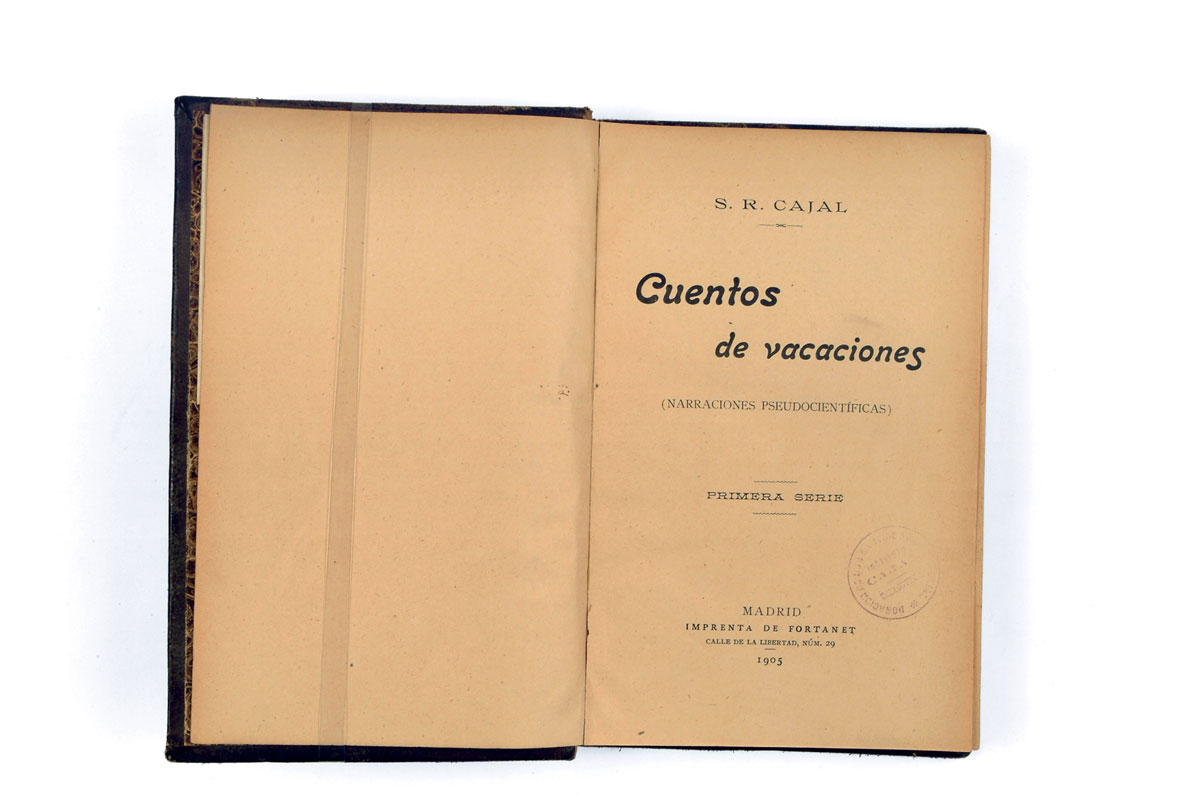
Vacation stories
Santiago Ramón y Cajal wrote twelve scientific fiction stories between 1885 and 1886, but five of them were not published until 1905, under the title Vacation stories. Five science fiction tales. All these stories refer to scientific progress and all include microscopes and the field of bacteriology, which he considered as «seeing the big in the small» (Collado-Vázquez & Carrillo, 2016; Otis, 2001).
They are fictional stories, but with a marked pedagogical character through which he tried to banish false beliefs and absurd superstitions. These stories raise difficult social or moral dilemmas that were often motivated by advances in science or the inadequate scientific education of the general population. Through them, Ramón y Cajal showed his political, religious, moral, educational, and scientific ideas. He shared Jules Verne’s desire for science and gave his stories the greatest possible realism and plausibility, basing them on facts or rational hypotheses related to the advances of modern science and psychology (Aguilar-Alfaro & Giménez-Mestre, 2006; Escobar, 2009; Aguilar-Alfaro & Giménez-Mestre, 2006; Escobar, 2009).
«For a secret offense, secret revenge» tells the story of a reparation in which bacteriology plays an important role, after the main character – a scientist – uses it to get revenge on his wife and her lover (although he later backs out of his plan and tries to save her). He also investigates to find the elixir of eternal youth, although what he obtains with his experiments is seniline, which has the exact opposite effect (Collado-Vázquez, 2016; Iniesta, 2014; Ramón y Cajal, 1999).
Another one of the Vacation stories is «The fabrication of honour». The main character is Doctor Alejandro Mirahonda, who is highly esteemed in his village – Villabronca – for having discovered a serum that maintains peace among all the population, without arguments or bad feelings. What they do not know is that this serum does not exist, and that in reality the doctor is controlling their will through hypnosis (Aguilar-Alfaro & Giménez-Mestre, 2006; Iniesta, 2014; Mata-Induráin, 2002; Ramón y Cajal, 1999).
Another doctor is the protagonist in «The corrected pessimist». He is a young man disillusioned with his profession, who is given a strange power for a year: a vision capable of capturing the slightest detail, as if he had microscopes instead of eyes. Such accurate vision is more of a punishment than a virtue, since he sees every flaw, insignificant as it may be, and is no longer able to capture the beauty of things (Collado-Vázquez & Carrillo, 2016; Iniesta, 2014; Ramón y Cajal, 1999).
The dialogue between science and religion is also present in these stories through the conversations between two men educated in very different ways in «The natural man and the artificial man» (Collado-Vázquez & Carrillo, 2016; Iniesta, 2014).
The last story he published was «The accursed house», in which a doctor, bankrupted because of an unfortunate shipwreck, buys a house that nobody wanted because it was said to be haunted and affected by a sordid curse. The protagonist discovers, using his scientific knowledge, that what happened in this house had nothing to do with witchcraft, but with natural causes that could be perfectly explained by chemistry and bacteriology. A similar thing happens in the work The Carpathian castle (1892) by Jules Verne (Collado-Vázquez & Carrillo, 2016).
All these stories, with some satirical brushstrokes, are characterised by the presence of scientific aspects and by their pedagogical and moralistic purpose. The author wanted to contribute to the development of education to improve scientific and technical skills in Spain. At the time however, his scientific fiction stories had very little impact, unlike the works of Jules Verne or the fantasy novels by the London-based author, H. G. Wells. The work of the latter included experiments and scientific breakthroughs, mixed with fantastic narratives involving time travel, extraterrestrials, research into invisibility, and hybridisation. Like Cajal, Wells not only presented a fictional story, but also emphasised philosophical, ethical, social, and scientific details, and in some cases, warned about the risks that the inappropriate use of scientific and technological advances might entail (Collado-Vázquez & Carrillo, 2016; Iniesta, 2014; Mata-Induráin, 2002).
The reason the stories written by Cajal had a limited impact was that the first edition of Vacation stories did not have a formal distribution. The author printed some copies that he distributed among friends and family members, and so the impact of their pedagogical purpose was minimal at that time, although they did later reach a wider audience (Collado-Vázquez & Carrillo, 2016).
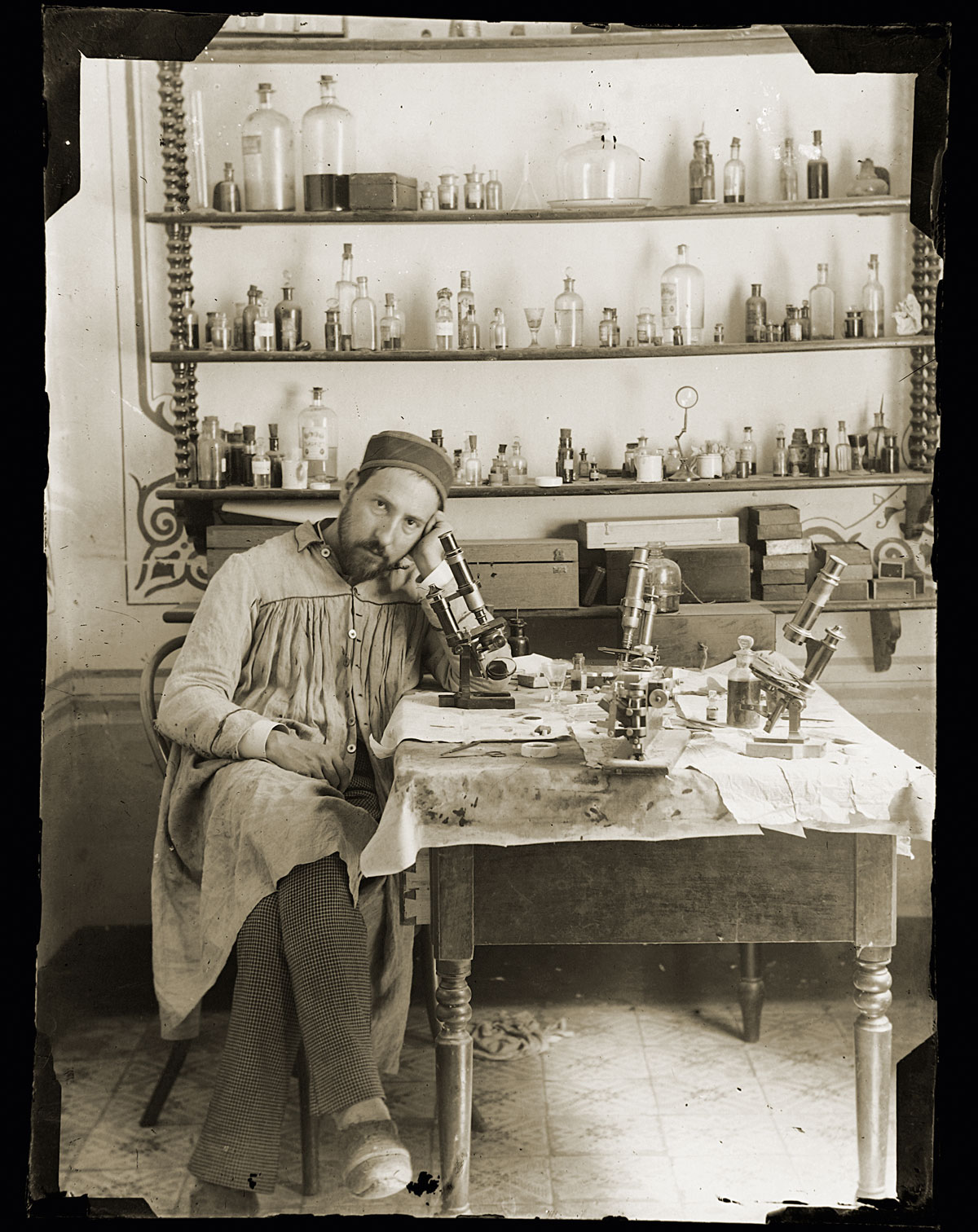
Anticipatory tales
A few years ago Nana Ramón y Cajal – the histologist’s granddaughter – and her husband García Durán rescued one of the stories that was never published, entitled La vida en el año 6000 (“Life in the year 6000”), in which the author shows a certain capacity for prediction in relation to scientific progress (Collado-Vázquez & Carrillo, 2016) when he refers to telemedicine. In 1967, the Massachusetts General Hospital began a pioneering pathology imaging program using a communications network based on interactive television that connected the hospital to the Boston Logan Airport emergency centre. It was the birth of telemedicine, even though Cajal had already talked about it in La vida en el año 6000, many years previously and shortly after the telephone was patented, with his references to «diagnostic machines» and «cytogenometers». For example, in the work, Ramón y Cajal describes an assistant sending telephone tapes showing the graphics of a valvular endocarditis and the doctor writing the figures on a diagnostic machine.
This was not the only time that Cajal was ahead of his time. In Vacation stories he also described the cycle of human sexual response (excitement, plateau, orgasm, and resolution), long before Master and Johnson scientifically described it between 1959 and 1966. Santiago Ramón y Cajal described an imaginary device that could detect sexual response – a chaise longue with pressure receptors on its legs (Aleixandre-Blanquer, 2005; Collado-Vázquez & Carrillo, 2016).
Comenzaba la gráfica con ligeras inflexiones; minutos después las curvas se accidentaban, mostrando grandes valles y montañas; luego, el ritmo adquiría desusada viveza, desarrollándose en paulatino crescendo hasta que por fin, llegado el allegro, una meseta audaz, elevadísima y valientemente sostenida, cual calderón formidable, cerraba la inscripción, que retornaba lánguida y mansamente al reposo inicial.1 (Ramón y Cajal, 1999, p. 10)
In short, Santiago Ramón y Cajal was interested in scientific fiction ahead of his time, as were some of his imaginative ideas and his wish to give his stories an informative and pedagogical purpose. He aimed to instil rational thinking and to steer away from superstitions and misconceptions.
Notes
1. «The graphic record began with subtle inflections, but minutes later, the curves seemed to have been seized by a sudden fit of illness, exhibiting great mountains and valleys. The rhythm then assumed an unwonted liveliness, which became a gradual crescendo until, at last, the allegro movement came – a bold, extremely high, and valiantly sustained plateau. After a magnificent pause, the inscription came to an end, returning languidly and meekly to its primitive state of repose.» Translation: Ramón y Cajal, S. (2001). Vacation stories: Five science fiction tales. Urbana: University of Illinois Press. (Go back)
References
Aguilar-Alfaro, L., & Giménez-Mestre, M. J. (2006). Doctor Bacteria: Science fiction writer. Santiago Ramón y Cajal. Escritor de ciencia ficción o cómo «ver lo grande en lo pequeño». In J. A. García-Rodríguez, J. González-Núñez, & J. Prieto-Prieto (Eds.), Santiago Ramón y Cajal. Bacteriólogo (pp. 193-200). Barcelona: Ars Médica.
Aleixandre-Blanquer, F. (2005). La respuesta sexual humana y don Santiago Ramón y Cajal. Revista Internacional de Andrología, 3(3), 133. doi: 10.1016/S1698-031X(05)73260-X
Collado-Vázquez S., & Vázquez-Vilà, M. A. (2013). ¿Los biopics pueden ser útiles en docencia? En S. Collado-Vázquez, & J. M. Carrillo (Eds.), Cine y ciencias de la salud. Aplicaciones docentes (pp. 95–132). Madrid: Dykinson.
Collado-Vázquez, S., & Carrillo, J. M. (2016). Santiago Ramón y Cajal en la literatura, el cine y la televisión. Revista de Neurología, 63, 469–477.
Delgado-Bona, G. (2003). Cajal, retazos (151 años). Revista de Neurología, 37(1), 89–91.
De Torres Martínez, J. C., & García Antón, C. (1998). Estudios de literatura española de los siglos XIX y XX. Madrid: Raycar.
Escobar, A. (2009). La neurociencia mexicana y los bisnietos de Cajal. Revista de Neurología, 48(4), 169–170.
González-Rodríguez, M. D. (2003). La ciencia en España en la encrucijada finisecular (siglo XIX). Revista Iberoamericana de Ciencia, Tecnología y Sociedad, 1(1), 85–108.
Iniesta, I. (2014). Neurología y literatura 2. Neurología, 29(4), 242–248. doi: 10.1016/j.nrl.2011.02.007
Klimovsky, L. (Director). (1959). Salto a la gloria [pel·lícula]. Spain: Aspa Producciones Cinematográficas.
Laín Entralgo, P. (2008). Escritos sobre Cajal. Madrid: Triacastela.
Mata-Induráin, C. (2002). Distracciones literarias de un médico histólogo: Los Cuentos de vacaciones (1905) de Ramón y Cajal. Pregón, 20, 42–45.
Miscione, G. P. (2015). Las ranas de Galvani, la pila de Volta y el sueño del doctor Frankenstein. Hipótesis: Apuntes científicos uniandinos, 18, 54–65.
Novell Monroy, N. (2008). Literatura y cine de ciencia ficción. Perspectivas teóricas. Barcelona: Universitat Autònoma de Barcelona.
Oliveros-Aya, C. (2015). El sueño de Frankenstein. Hallazgos, 12(23), 117–144. doi: 10.15332/s1794-3841.2015.0023.06
Otis, L. (2001). Ramón y Cajal, a pioneer in science fiction. International Microbiolgy, 4, 175–178. doi: 10.1007/s10123-001-0033-0
Pérez-Rodríguez, A. (2007). Jules Verne: ¿Padre de la ciencia ficción? Revista digital universitaria, 8(9), 1–6.
Ramón y Cajal, S. (1999). Cuentos de vacaciones. Narraciones pseudocientíficas. Madrid: Espasa Libros.



